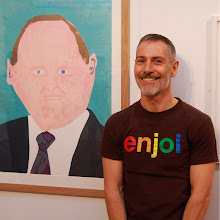The original print had several layers created by overlaying several blocks of lino, so I have started by cutting three blocks at 60 x 60cm. I may need more blocks eventually, but I can cut those later. I use lino bought from an art shop which can be delivered in a large roll, so I can cut the sizes I want from it.
I am going to start with the "keyplate" which is the potential final layer to be added to the print. It is a London skyline. I have photocopied a printout from a manipulated photograph I have taken, and then transferred the photocopy onto the lino. Remember to reverse the image onto the plate so that when you print it is the right way around.
Once transferred, I have begun by cutting into the lino, using traditional linocut tools. I decided at this stage to cut the sky away, but using horizontal cuts only, just in case I want to use the marks that the cut-away part of the block gives me later on. It is just an option, which I may or may not use.
Here is the block with the sky cut away and an application of thick stopout where the cityscape meets the Thames.
I have painted this line to protect the lino beneath from the caustic soda etch that I will apply later. I want the "edge" where the city meets the water to be more ragged and not a cut mark.
I have then applied more thick stopout to the block with a stiff scrubbing brush to give me a textural mark. From experience, about 40 to 50% of this stopout will be eaten away by the caustic etch, so what you see, ain't necessarily what you get!









This looks interesting but rather random, I'm wondering if you have found any other way to get more control.
ReplyDelete